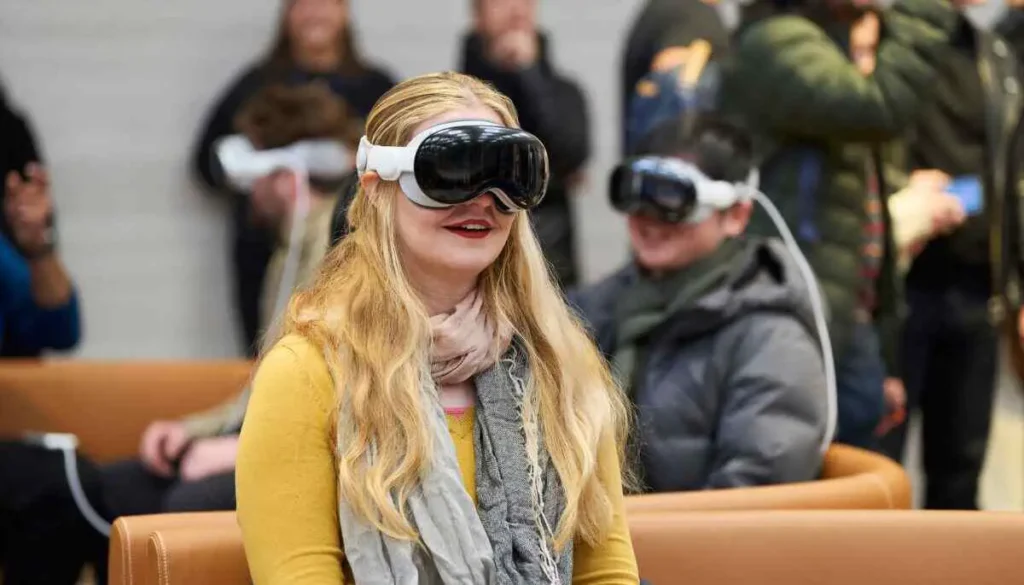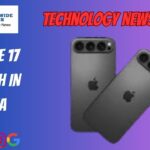Apple Vision Pro, the game-changing device that redefines immersive experiences. From cinematic movie nights to groundbreaking gaming adventures, Apple Vision Pro unlocks a universe of possibilities. Dive into our top 10 things you can do with this innovative technology, and discover how it can transform your entertainment, gaming, and productivity habits.

According to a dissection of the headset, the Apple Vision Pro, the company’s cutting-edge “spatial computer” that went on sale in the US last week, has an enhanced EyeSight display that uses multiple films of the wearer’s eyes simultaneously.
The three layers in the glass shell of the headset enable stereoscopic display of a three-dimensional representation of the wearer’s eyes. The reason EyeSight looks darker than in Apple’s demonstration movies of the headgear can also be explained by the breakdown.
The front of the headset, which looks like a pair of ski goggles, is equipped with three layers, according to a detailed post by iFixit that delves into the components inside the Apple Vision Pro. These layers include an OLED screen on the front, a lenticular layer, and a widening layer, which when combined produce a 3D representation of the wearer’s eyes.
Apple fitted a lenticular lens on top of the OLED display of the Vision Pro, which is intended to show distinct images from different angles, in order to create the stereoscopic effect for the 3D image of a person’s eyes. According to iFixit, the Vision Pro can create a “3D face via the stereoscopic effect” by slicing, interpolating, and displaying face images from tiny angles that serve the left and right eyes.
The company explains that because both images must be exhibited at a lower resolution due to fitting on the same monitor, the outcome would be fuzzy. In the meantime, to prevent the eyes from appearing overly near to the wearer’s nose, the second lens on top of the Apple Vision Pro increases the 3D view of the other lenticular layer.
When these layers are combined, the wearer’s eyes are less visible through the EyeSight function, and their viewing angles are likewise shortened. In another video posted by iFixit, the OLED display beneath the two layers is seen with what appear to be some artefacts at the left and right borders of the screen. These artefacts are only noticeable after the other layers are taken off.
The 10 Things You Should Know About Apple Vision Pro
There is a lot of hype surrounding any new product that Apple releases. However, what occurs when Apple introduces a new line of products? When individuals talk a lot—more than they really should, at least on social media—the buzz becomes unstoppable. With the Apple Vision Pro, that is what is taking place. Apple Vision Pro, which combines virtual and augmented reality, promises to be more than simply a beautiful headset.
Also Read: TOP 5 UPCOMING 5G MOBILES IN INDIA 2024 UNDER RS 20,000
It’s a new computing platform:
While phrases like “metaverse” and “extended reality (XR)” that you may hear in the business refer to similar concepts, Apple spoke about “spatial computing” and “levels of immersion.” At Factory 42, “spatial computing” has always meant a product that can recognise your physical surroundings and integrate digital content into that area so you can engage and fully experience it with all of your senses.
A large set of technologies in a small sleek package:
It comes as no surprise that Apple, in its foray into the spatial computing sector, has produced a high-end product packed with cutting edge capabilities in a wonderfully designed and constructed form factor. Everything we’ve observed over the years indicates that comfort is crucial for potential clients.
It’s a high price tag:
Apple is marketing this as the gadget that will take the place of your expensive TV, camera, and gaming consoles in order to appeal to an upscale market. With steep price tags for early adopters, Apple is a master at creating customer demand for new items. The 1984 Mac launch price, for example, would be $7,400 in 2023 currency.
It will launch with a large content library:
Customers may experience a vast library of content right away thanks to the Vision Pro’s compatibility for existing iPhone, iPad, and AppleTV apps. This will boost customer confidence and provide Apple a competitive advantage.
Uses eyes, hands and voice together:
Unlike other devices, the Vision Pro doesn’t require any extra hardware controllers. Encouraging users to engage in natural interactions is crucial to preserving immersion.
Human connection a key focus:
You can see other individuals in your area and they can see your face and eyes thanks to the Vision Pro. By doing this, the sense of isolation that is sometimes mentioned as a drawback of VR products is avoided. In recent years, we have focused more on fostering interpersonal relationships within immersive experiences, and audiences have responded favourably to this strategy.
Privacy & security front of mind:
Your eyes, face, and body movements may be monitored by up to 12 separate cameras and sensors on the headset, but your information is kept private and safe because these data aren’t shared with other apps.
A single device for both work and home:
Apple provided instances of how Vision Pro may improve working from home and remotely, as well as in the workplace. With many of the features utilizing the capabilities of Apple’s current hardware and cross-platform ecosystem, this plays to Apple’s advantages.
Tim Cook’s “iPhone”moment:
With this new product, Tim Cook has the opportunity to further solidify his Apple legacy and repeat the words that will live on forever: “..and one more thing!” This high level of support, along with the Disney relationship that was announced, demonstrate Apple’s dedication to this new platform and the good effects that we anticipate it will have on the broader industry.
This is just the beginning:
Industry veterans may find the use cases presented at the speech unremarkable, but Apple purposefully chose not to overwhelm people with a lot of sophisticated 3D capabilities at this time, knowing that consumers can only process one new idea at a time.
Only 15 days have passed since Factory 42 celebrated its seventh year of using spatial computing, so we know how difficult it can be to create these novel experiences, but it can also be incredibly rewarding when you succeed and witness the good effects they have on clients.
In this next exciting stage for the entertainment and technology industries, we’re excited to work with amazing partners to create one-of-a-kind experiences. We’re always pleased to talk if you’d like to learn more or explore new options.










